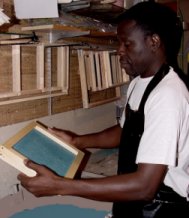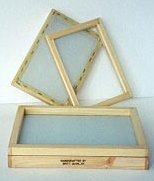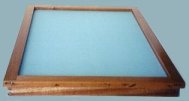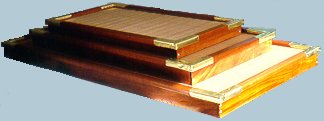
MOULDS AND DECKLES
- Screening
- Moulds
- Moulds With Form Fitting Deckles
- Larger Moulds
- Custom Wove Moulds
- Japanese Moulds
- Envelope Deckles
- photo taken at Delmar Rempel's studio in Saskatoon.
The Paperwright
brittq@trytel.com
 |
Featured Article: MOULDS AND DECKLES
- photo taken at Delmar Rempel's studio in Saskatoon. |
The main piece of equipment used in hand papermaking is called a mould and deckle. The mould is a screened frame that catches pulp to help form a sheet of paper. The deckle is a frame that sits on top of the mould, helps catch pulp and defines the edge of the paper.
Moulds and deckles can be made from all kinds of materials including pine, oak, mahogany and plastic. Pine is an economical soft wood that works well in water. Mahogany is an expensive hardwood that stands up very well to daily use and is the choice of many production papermakers. While plastic is another choice, it doesn't have the strength or durability of wood.
A variety of screens are available. Polypropylene, bronze, copper, brass, aluminum and window screens are all used on moulds with various degrees of success. Window screening and/or aluminum are not good choices because they sag or warp after a couple of uses. Polypropylene screening is a popular economical choice because of its durability and tautness. Polypropylene can be wetted down and then dried with a hairdryer; the heat causes it to shrink making a loose screen tight again. Bronze mesh, a more expensive screening, is used for woven moulds and is supported by ribs built into the underside of the mould. Copper, brass and stainless steel mesh can be used in the same manner. Laid chain bronze screening used in traditional European moulds is made from very thin, round bronze sticks woven together by bronze wire at one-inch intervals.

Paperwright basic moulds are made from either number-one grade pine or mahogany wood, and are sreened with a 30/30 polypropylene mesh. The 30/30 refers to the number of threads per square inch of material. A 30/30 mesh allows for plenty of water to pass through without losing pulp through the screening. For someone starting out, a pine mould with polypropylene mesh is a good choice. A pine mould is economically priced and produces a fine paper. It is a durable mould which, if properly cared for, can give you many years of use.
The deckle is a simple frame that sits on top of the mould. This is called a flush deckle because it sits right on top, and the bottom part of the deckle is flush against the top part of the mould. Think about it as being like taking two simple picture frames and stacking one on top of the other.
Because stainless steel screws and staples are used, you don't have to worry about rust developing or a screen coming loose. The moulds are waterproofed to prevent warping. Warping occurs as water soaks into unprotected wood as it is repeatedly dipped into water.

MOULDS WITH FORM FITTING DECKLES
Form fitting Paperwright moulds can be made of either pine or mahogany. The form fitting deckle is a frame that has part of its wood routed out from the bottom of the frame, creating inner and outer lips. The inner lip presses against the screen and forms a tight edge for paper formation. The outer lip goes down around the mould and holds the deckle in place so it doesn't have the chance to move (like a top on a shoe box).
LARGER MOULDS
Because of the cost of custom wove moulds, clients have asked for larger moulds that are more economical. Larger moulds need a supported screen because of the amount of water pressure created while pulling a sheet of paper. To do this, I have used eggcrate (used in ceilings as light covers) as a support under the screen. It is then secured into place with either mahogany strips or brass inserts. The brass inserts can be removed to allow the eggcrate to come out for easier cleaning. Plastic eggcrate support can cause a slight watermark on papers. However, this is eliminated by doubling the polypropylene screening on top. The drainage is at the same rate as with a single screen. For the largest moulds, a removable mahogany brace is available to help support eggcrate.

Wove moulds are built in the same way, but are much more detailed in design. Small, thin mahogany ribs, with 1/16" holes running along the length of each rib, are built into the underside of the mould. A support bronze mesh is laid on top of the ribs and brass string is used to handsew the mesh to the frame. On top of the support mesh is placed a 30/30 bronze mesh that is handsewn to the support mesh. This provides an even, supported surface for paper formation. A brass strip is nailed around the edge of the mesh to secure the mesh to the frame. Protective brass coverings are applied to the corners of the moulds and form fitting deckles.
The Paperwright also has a small amount of laid chain bronze available for custom moulds.
Paperwright Japanese moulds are handcrafted from mahogany or oak. A hinged deckle locks into place before sheet forming. The heat-shrinking polypropylene screen is detachable to allow for the Japanese style of couching. Handmade ribs support the screen.
Deckles can be made to create envelope or special shapes. The one complaint from papermakers about these types of deckles is that pulp tends to leak underneath them. To correct this type of leakage, the Paperwright has developed a simple, routed deckle that sits more flush on the screen. This has eliminated almost all leakage, allowing for crisp, clean edges to the shapes.
|
Whether you are just starting out or have been a papermaker for a long time, a mould and deckle can help make the experience of creating handmade papers a pleasure. The Paperwright is dedicated to producing moulds and deckles to meet your needs. Each mould and deckle is built from scratch at the Paperwright studio, using the best of materials. Improvements made to moulds have all been tested at the Ottawa School of Art in Canada, where The Paperwright provides a papermaking studio, classes, and workshops. It would be a pleasure to build a mould and deckle for you. |
Please feel free to email any questions you might have to brittq@trytel.com